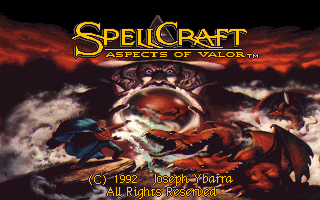From The CRPG Addict
SpellCraft: Aspects of Valor
United States
Tsunami Production (developer), ASCII Entertainment Software (publisher)
Released 1992 for DOS
Date Started: 27 July 2019
I was recently reminded of a nine-year old entry in which I remarked on the considerable variances in spell systems between fantasy RPGs. A lot of the stuff I said in the first year of blogging was ignorant nonsense, but this entry holds up. My thesis was that while many CRPGs may offer near-identical experiences when it comes to character attributes, equipment, NPC interactions, and combat, their approaches to magic are so variable as to almost be a fingerprint. “Fully describe the magic system of any game,” I said, “and there’s a decent chance that your description applies only to that game, or at least only to games in that series.” I then analyzed a number of categories in which spell systems varied.
The Ultima series was a good title to encapsulate the argument because it doesn’t even maintain spell consistency within the series. Every entry is unique. I think the series reached its apex in Ultima V, which featured the “syllable” system as well as the reagent system. I call it the apex, but the system was also full of unrealized potential. There were a couple of unlisted spells that you could figure out if you understood the logic behind syllables and reagents, but otherwise the spells were mostly handed to you in a spellbook. I’d like to see the same system in which the player has to figure out almost every spell, and moreover can create some fantastic combinations. If in Ultima V, KAL XEN summoned a creature and VAS FLAM created a great ball of fire, I don’t see why KAL VAS XEN FLAM wouldn’t summon a great creature of fire.
 |
| I agree that neither “accomplishment” nor “danger” seem like this guy’s strong suits. |
One thing that never makes sense to me about spells in Dungeons and Dragons settings is how relentlessly predictable they are. It makes no sense that if a mage can summon a fireball, he can only summon an enormous fireball that covers a 69-square area and does deadly damage to everyone within it. Once you know how to pull fire out of thin air, you ought to be able to figure out how to halve or double the recipe. A lot of other games give you the ability to vary the intensity of a spell without having to change to a completely different spell. This was one area in which Disciples of Steel improved upon the Gold Box engine.
SpellCraft offers a little of what I’m looking for in both areas. Its spells are created like recipes–a combination of “aspect” items (not unlike Elvira II in this regard), ingredients, and magic words, some of which can be varied to produce different effects. I’m a little hesitant to call the system exactly what I’m looking for because I don’t think there’s a lot of logic to the aspects and ingredients. But it may be that I just haven’t experienced the system long enough yet.
SpellCraft was conceived by Joseph Ybarra, the Electronic Arts executive who had produced the first Bard’s Tale games, Starflight, and Legacy of the Ancients (among others). In between presiding over the last days of Infocom (1988-1990) and taking a producer role at 3DO (1995), Ybarra ran his own company, drawing in Karl Buiter, creator of Sentinel Worlds and Hard Nova. Most references to Ybarra’s company call it Ybarra Productions, and indeed that’s the title the team used for Shadow of Yserbius (1993) and Alien Legacy (1994), but for a while at the beginning he must have flirted with “Tsunami Productions.” Anyway, SpellCraft seems to be a completely original conception; I can find nothing like it in Ybarra’s history nor the histories of any of the programmers.
The manual features one of the worst-written backstories that we’ve encountered in a long time. (The manual is otherwise okay.) I’d blame Karl Buiter of “You beat me?!…I am destroyed” fame, but he’s not credited on the manual. I spent a few paragraphs trying to deconstruct how bad it is, and why it’s bad, but it was taking so long I may actually save it for an entire entry. I invite you to click on that link, go to Page 6, and make any sense of it. This is the type of manual that could only have gotten past the production standards of a Japanese company running an American office.
The upshot is that magic was around on Earth for a long time, but its abuses led some wizards to create (or move to) the separate realm of Valoria. While the use of magic in “Terra” dwindled to weak cantrips and soothsaying, in Valoria wizards wielded devastating power and warred among themselves for centuries. Eventually, they came together in a Council of the Wise and elected a Magister to lead them, and war settled down into healthy competitions instead of all-out slaughter.
Unfortunately, the testing of atomic bombs in the 1940s on Terra happened to coincide with some powerful magic rituals in Valoria, with the result that a major rift opened between the two worlds. Here, the manual transitions to the game’s opening segments, though imperfectly because in-game screens say the rift is “tiny” and it was discovered recently. (Fortunately, the in-game text seems to have been penned by someone more competent than the manual backstory author.) The Magister, Garwayen, suggested that the council close the rift so that “our worlds would not come into conflict,” but the rest of the council–six wizards aligned to different “colleges” of magic–voted to enlarge it so they could conquer Terra. As if this wasn’t bad enough, Garwayen thinks that enlarging the rift will damage the “very fabric of reality” and thus potentially destroy both realms.
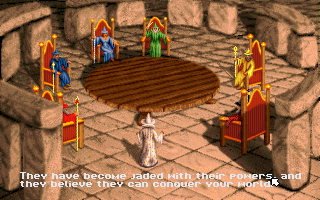 |
| Yeah, we’ll see how your “Fireball” spells perform against our ballistic missiles. |
Garwayen, “old and feeble” and unable to stop his six colleagues, looked for someone “born under the same conjunction of stars” who could absorb his magic. He found the answer in Robert Garwin, an American with “a modest life of no great accomplishment and no great danger.” Garwin unexpectedly receives a ticket to England from his “Uncle Gar” with the promise of an inheritance on the other end. Following “Gar’s” instructions, Garwin flies to Heathrow, rents a car, drives to Stonehenge, gets teleported to Valoria, and soon finds himself Garwayen’s apprentice.
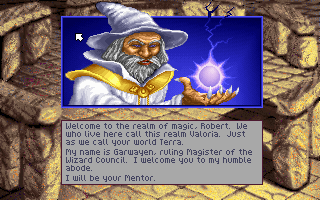 |
| The images are now in sync with the text. |
The player’s first choice is to pick a primary college of magic from among the classic four elements. Irene happened to be walking by as the choice was presented to me, and I decide to test the depth of my knowledge of my wife by giving the options to her. The issue was never what element she’d choose (fire), or how she’d make the choice (“Fire! Fire! Fire!” with a manic gleam in her eye) but whether she’d even let me finish reading the sentence before giving her answer. She had just come home from battling tourist traffic along the coast, so I’m proud to say that she did not.
The game eases you into its conventions with a few tutorials, starting with the creation of the first spell. In my case, it was “Fire Barrier,” a defensive spell. Creating a spell requires first selecting its “aspect” from among 48 potential objects you can collect. You then have to choose how many of that aspect to use in the spell’s creation, plus how many standard ingredients–powders, stones, candles, and jewels–will also go into it. Finally, you associate a “magic word” with the spell, which is really just a textual representation of the spell level. The first level of fire-based spells are all LUX, for instance.
 |
| Mixing a new spell. |
You get these recipes from a variety of sources, including arcane hints in the manual and NPC dialogue, but in this case Garwayen just told me what ingredients to use.
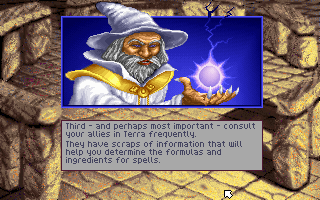 |
| Garwayen explains where to find information about spells. |
Once the spell is created, you have to go to your spellbook to mix any number of iterations of the spell, capped by how many ingredients you have on-hand. You can also make modifications, by adding more of some ingredients, thus hoping to vary the spell’s power or effects. Whether this works or not is governed by the “elasticity” of the ingredients, which you’re told during the initial spell’s creation.
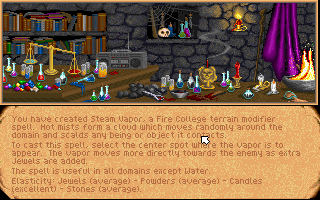 |
| A full description of the spell accompanies its creation. |
A spellbook that came with the game seems to have blanks for all possible spells, plus partial information for a lot of them. I imagined that the player is meant to fill in these blanks as he discovers new spells, so that’s what I started doing. I’m not sure that the “aspects” make any logical sense. Each is a physical object but has an “aspect of” something else. For instance, a fishook has an “aspect of pinpricks” which kind-of makes sense, but the domino mask as the “aspect of falling birds,” which makes no sense at all.
 |
| God damn those shriners! |
Garwayen then dropped a surprise in telling me that the various wizards won’t be defeatable with magic. For that, I’ll need a regular weapon. He gave me a Sword of Striking to use, then tossed me into the Earth Domain to check it out.
When you’re on a mission in Valoria, the interface changes to an axonometric window with environmental objects, enemies, and treasure chests. The numberpad moves the character, the function keys select spells, and the ENTER key casts them. The SPACE bar cycles the bottom-left window through a couple of options, including character statistics and a map. All of these actions have mouse alternatives. I feel like the graphics, good in the rest of the game, degrade significantly in the exploration window.
Enemies–in this case, something that looks like an orc–head for you the moment that they see you. Unfortunately, physical combat is pretty pathetic. You simply adopt a combat posture with a single keystroke and the game fights for you. If you hit any other key while in combat, you return to a non-combat posture. A single “life” bar indicates both health and spell points. It recharges relatively quickly as you walk about the environment. An early-game character can’t defeat more than one enemy on a single health bar, but you can defeat one, then run around before engaging the next. (In the early game, at least, the character moves faster than enemies.)
 |
| I send a fireball streaking towards an orcish creature in the Earth Domain. A chest is available for pickup to my south. |
Enemies drop bags of items (spell aspects and ingredients) when defeated. Chests scattered about the world deliver these in greater volume. When you’ve defeated all the enemies and collected all the chests, you return to your home base–a “Stone Circle” that has its own health bar for reasons that must become apparent later–via a keystroke.
I ran three practice missions fighting orcs before Garwayen decided we’d better move on. He had me create a “Fireball” spell (red fez aspect, three powders, six candles) and then sent me to fight more orcs. I used the spell for a couple of them, but I defeated most in combat to conserve ingredients.
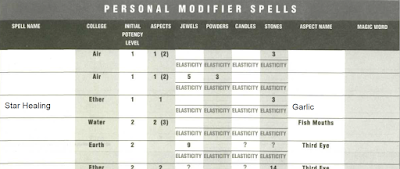 |
| Logging the “Star Healing” spell in the spellbook. |
For the next spell, he wanted me to create something called “Star Heal,” from the “ether” college, but he would only tell me that the “aspect grows naturally” and that the “proportions for the spell are one and three.” I consulted the spellbook and found only one “personal modifier” spell with 1 of one thing (the aspect) and 3 of the other (stones). Of aspects that “grow naturally,” I only had garlic and onions. Garlic and 3 stones turned out to be the answer.
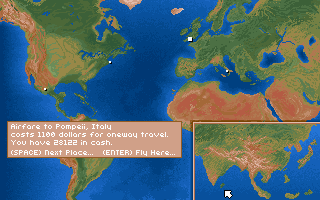 |
| A map of Terra shows me the magic hot spots. I guess Oceania doesn’t have any. |
At this point, the game took an odd turn, as Garwayen sent me back to Terra to purchase some more ingredients–particularly two vials of white liquid. I was presented with a world map, $20,000 cash, a pomegranate, and the ability to travel to Salem, Massachusetts (USA); Teotihuacan, Mexico; Pompeii, Italy; and back to Stonehenge. Each one-way ticket cost at least a few hundred dollars. At each location, I could talk to an NPC and buy or sell ingredients from him.
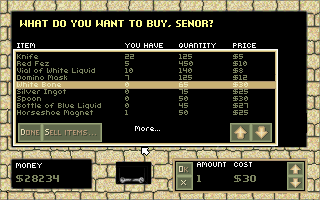 |
| Trading ingredients. |
Stonehenge’s NPC was a hippie named David Greenbriar who wanted a magic pomegranate so much he was willing to pay $10,000, so that bolstered my initial funds. In Salem, I made contact with Selina, a guide at the Witch Museum (this was accompanied by what I can attest is a real photo of Salem’s Washington Square), who told me to return if I ever found the Book of Witches. In Teotihuacan, a medicine woman promised to teach me a new magic word if I brought back an opal from the Fire Domain. Pompeii’s NPC was an English tourist interested in ancient artifacts. In each location, I bought 5 of any ingredient they were selling that I didn’t have. I still had over $27,000 when I returned to Stonehenge, so maybe I was a bit conservative on my first trip.
 |
| I think I might have met this NPC in real life. |
(Aside: As a former resident of Salem who really got into the history of the city, I don’t care for it when movies, television shows, books, and games suggest that the city was ever the site of any “real” magic and witchcraft. I have a particular distaste for the choice of the Salem Police Department to put a classic witch-on-a-broomstick on its departmental patch. Between 1692 and 1693, twenty residents of Salem were executed on false accusations of witchcraft, and I feel like it insults their memory to suggest that the accusations were anything but unfounded hysteria. I do appreciate, however, how the various museums of the city use the “witch” title to lure in tourists–but then give them a sober account of a tragic history.)
The session wrapped up with the creation of a new spell called “Steam Vapor” that required me to interpret a clue from a quote in the manual. After that, I got access to my workshop, where I can create and modify spells.
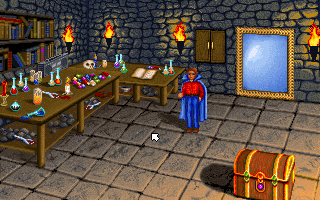 |
| This is a pretty sweet pad. |
Looking into the mirror in the workshop shows character statistics and inventory. It suggests among other things that I will eventually find other weapons and armor upgrades plus various magic “totems.” My maximum health has doubled (from 50 to 100) since I started the game; I don’t know if this is the result of solving missions, defeating enemies, or both. Either way, it counts as a sort-of character development that qualifies the game as an RPG. I assume my attack and defense scores can also increase.
 |
| The “character sheet.” |
Two subsequent missions took me to the Air Domain and the Fire Domain. The Air Domain looked like it was covered in snow, though it was supposed to be clouds, and stepping off the clouds results in instant death. The Fire Domain cracked me up because it’s just like the Earth Domain except all the trees are on fire and the lakes and rivers have lava instead of water. How did the trees grow there in the first place? The Fire Domain had more orcish monsters, but the Air Domain gave me phantom-like air creatures. These enemies have been easy enough to defeat with my sword so far. I assume that changes.
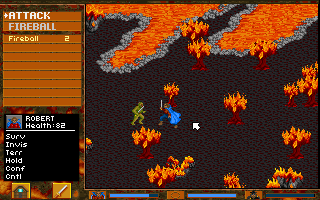 |
| The Fire Domain is serious about its theme. |
Both of the areas had special large chests to find. One had the Teotihuacan woman’s fire opal; the other had 12 bottles of green liquid and 14 jewels. The green liquid is apparently the base of a powerful mind magic spell, but Garwayen says I need someone on Earth to give me the magic word first.
 |
| Fighting ghostlike creatures in the Air Domain. The game notes that this mission has 3 enemies, 1 large chest, and 1 small chest left to find. |
I like the spell creation system and the hub-and-mission approach. Jetting around the real world is weird but inoffensive. I look forward to seeing how SpellCraft develops. I’m glad I didn’t reject it.
Time so far: 3 hours
Original URL: http://crpgaddict.blogspot.com/2019/07/game-338-spellcraft-aspects-of-valor_30.html

